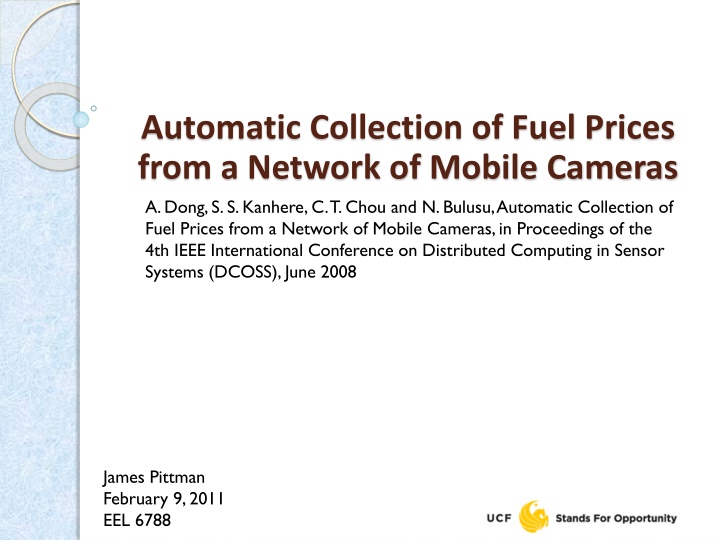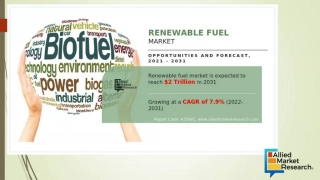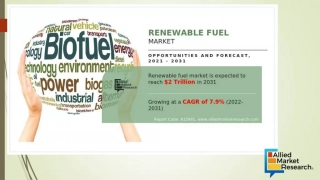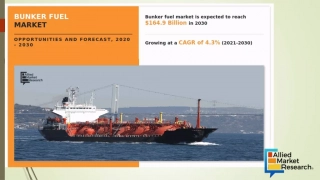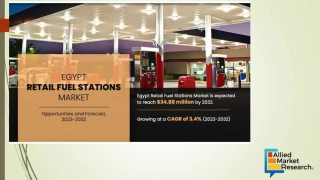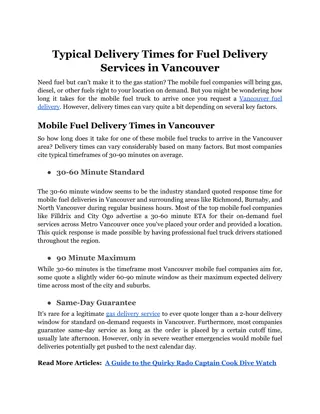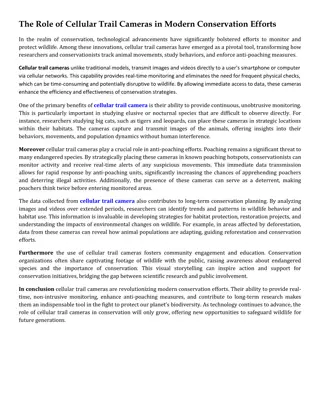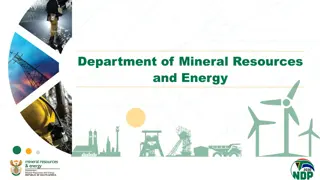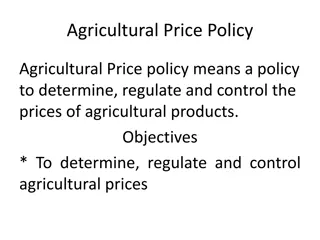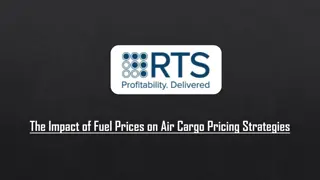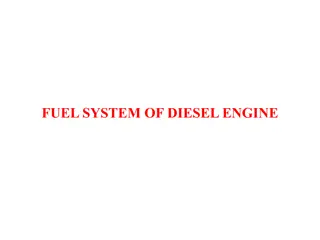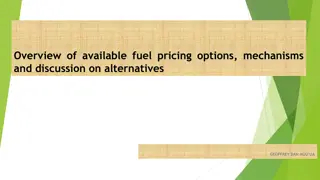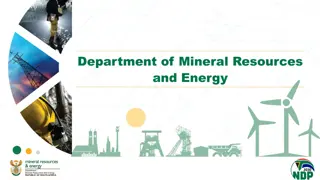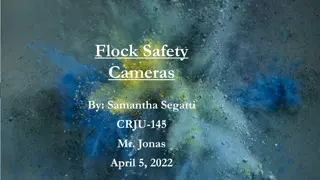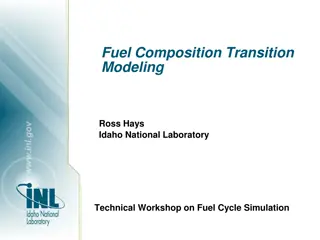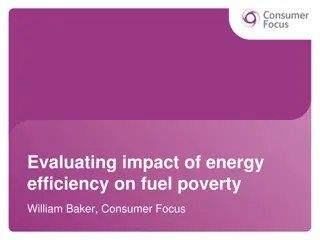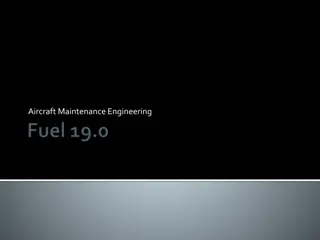Automatic Collection of Fuel Prices from Mobile Cameras
This paper discusses the implementation of wireless sensor networks for collecting consumer pricing information, specifically focusing on fuel prices using mobile cameras. The system design incorporates computer vision algorithms and GPS/GIS contextual information for automatic extraction of pricing data from fuel stations. The framework leverages the SenseMart concept to incentivize data sharing among users.
Download Presentation

Please find below an Image/Link to download the presentation.
The content on the website is provided AS IS for your information and personal use only. It may not be sold, licensed, or shared on other websites without obtaining consent from the author.If you encounter any issues during the download, it is possible that the publisher has removed the file from their server.
You are allowed to download the files provided on this website for personal or commercial use, subject to the condition that they are used lawfully. All files are the property of their respective owners.
The content on the website is provided AS IS for your information and personal use only. It may not be sold, licensed, or shared on other websites without obtaining consent from the author.
E N D
Presentation Transcript
Automatic Collection of Fuel Prices from a Network of Mobile Cameras A. Dong, S. S. Kanhere, C. T. Chou and N. Bulusu, Automatic Collection of Fuel Prices from a Network of Mobile Cameras, in Proceedings of the 4th IEEE International Conference on Distributed Computing in Sensor Systems (DCOSS), June 2008 James Pittman February 9, 2011 EEL 6788
Outline Introduction Background System Design Computer Vision Algorithm Evaluation Related Work Conclusions 2
Introduction Wireless sensor network (WSN) technology has been applied to many different domains This paper presents a concept where WSNs are used for collecting consumer pricing information The specific target for this paper s effort is in gathering pricing from fuel (gasoline) stations 3
Introduction Two stations on the same corner of an intersection can have greatly different prices for fuel Currently websites such as Gaswatch, GasBuddy, and others either: Send workers out every day multiple times to collect and track fuel pricing data. Rely on input from volunteer site users This is highly labor intensive and inaccurate since stations often update prices at different times of the day 4
Background - SenseMart The authors are re-using the Sensing Data Market (SenseMart) framework they proposed in an earlier paper The SenseMart concept is similar to participatory sensing. It leverages existing infrastructure (WSNs) for data collection and encourages the users to share their data to accomplish some high level task. 5
Background - SenseMart The SenseMart framework facilitates the data exchange using a BitTorrent style concept They incentivize the system by giving a return to the users proportionate to their contributions to encourages data sharing. They did not detail what the return was other than access to accurate data on gas prices. 6
System Design The proposed system has 2 methods of operation 1. Fuel price collection 2. User query The first is the focus of this paper. Automatic triggering of users phones Use of computer vision algorithms + GPS/GIS contextual information to extract the pricing info 7
System Design Camera Sensor Primary function automatic capture of images of fuel price boards Assumed that participating users have cameras mounted in car on dashboard on passenger side (in Australia) System could also interface with built in car camera vision systems and transfer data via Wi-Fi or Bluetooth to mobile phones 9
System Design Camera Sensor A control unit in the mobile phone oversees the capturing operations. It periodically polls the GPS receiver to obtain the current location A GIS (geographic information system) app such as Google maps or TomTom is required on the phone The GIS on the phone is then queried (using GPS location) to gather local contextual information 10
System Design Camera Sensor If a gas station is known to be close, the control unit estimates viability for image capture (camera facing, distance to target) If the situation is deemed viable the camera is activated, images are captured and the camera is deactivated The resulting images along with the associated meta-data (location, time of capture, and any GIS data such as station brand) are passed to the data-upload unit for upload to the central server 11
System Design Data Transport Any data captured by the camera along with the meta-data is transferred to the data upload unit This unit is generally the ability of the mobile phone to access the internet via 3G or Wi-Fi. The device establishes a TCP connection with the server and uploads the data. The backup/alternative method is to use multimedia SMS for the data transfer 13
System Design Central Server The central server stores all of the data and runs the computer vision algorithms. Processes the images Extracts the fuel prices The server also handles the reception of the images, and processing / storing of the associated meta data 14
System Design Central Server The server processes all of the data in steps 1. Detect a fuel board 2. Detect the section with the numbers 3. Crop the image to the numbers and normalize to a standard size & resolution 4. Extract the numbers 5. Classify the values 6. Report fuel prices 15
Computer Vision Algorithm Pictorial overview of the algorithm 16
Computer Vision Algorithm Challenges to overcome 1. Objects obscuring the fuel price boards 2. Background color similar / identical to the price board 17
Computer Vision Algorithm 3. Blurred or unfocused image captures (often due to capturing while sensor in motion) 4. Sections of the board that share characteristics with the prices (adds, borders) 18
Fuel Price Board Detection Detecting an fuel board and identifying its location in any given image is challenging Authors use GPS and GIS information to reduce the difficulty of the problem Each fuel brand has a generally unique color scheme Meta data from GPS/GIS can be used to tag incoming images with fuel brands to guide the system in identifying color information 19
Fuel Price Board Detection There are 2 prominent color schemes for representing images: RGB and HIS (Red- Green-Blue and Hue-Intensity-Saturation) HIS is illumination independent but computationally complex RGB is illumination sensitive, but computationally efficient Authors work with RGB due to targeting mobile applications 20
Fuel Price Board Detection RGB is an additive color space, making it easy to extract a single color component Each pixel is represented by red, green and blue color components They extract a single color by boosting that channel and subtracting the other components To extract the blue color: ) , ( * 2 ) , ( y x f y x B b = ( , ) ( , ) f x y f x y r g 21
Fuel Price Board Detection The first step used by the authors is color thresholding The objective is to classify all pixels as either Object pixels (in areas potentially containing an object) Background pixels (everything else) This produces a binary image The difficulty in this is selecting the correct threshold to separate Object and Background pixels. 22
Fuel Price Board Detection They were unable to design a single color threshold to work with all images To resolve this they took all of the images and classified them into groups based on lighting conditions Each group was then analyzed and a threshold was derived based on the average intensity 23
Fuel Price Board Detection The next step merges adjacent regions together to form a complete price board Finally connected component labeling is employed to connect pixels into components (all pixels in a component share a physical connection and an intensity range) 24
Dimension Comparison Using apriori knowledge about general fuel board dimensions, overly large and overly small regions are excluded Ratios were devised to take in account differences in angles, and distance to sensor Variables correspond with: W width, H height Of the region in the image W image W i 30 H i 1 5 . 2 W i 26
Color Histogram Comparison The second part of the post processing is a histogram comparison algorithm Compares histogram distribution of candidate region to a template of the price board. Compute a squared distance between the candidate histogram (hi) and the reference histogram (hj). K = number of histogram bins. 2 [ ( ) ( )] h m ( h m ( K 1 = m = i j 2 ( , ) h h i j + 2 ) ) h m h m 1 i j 27
Color Histogram Comparison Since turns out to be a large number they normalize it against the number of bins (K) and the width of the image (Wi) Dnorm = * K Wi Based on test results they have come up with a threshold of Dnorm 2.5 If the value of Dnorm is under this threshold, the region is very likely a price board 28
Color Histogram Comparison Template (a) Histogram(d) Example (b) Histogram(e) Other Region in Image (c) Histogram(f) 29
Fuel Price Classification Character Extraction Once the fuel board has been detected and located in the image the price must be extracted Due to the nature of the board (color choice, low noise) it can be converted to a binary image. This significantly reduces the complexity of character extraction 30
Character Extraction A bounding box algorithm is applied to the image to crop each character The cropped characters are normalized to a 50x70 pixel standard size image Each character is broken up into 35 10x10 pixel images that are used to create a 35x1 feature vector of the average intensity 31
Character Recognition Feed-forward Back-propagation Neural Networks (FFBPNN) are used in the character recognition Trained on characters from 20 sample fuel boards A priori knowledge of price placement is used as a base to know what price corresponds to what fuel type. 32
Evaluation Data Set 52 images from 5 Mobil and 3 BP stations Captured with a 5-megapixel Nokia N95 phone or 4-megapixel Canon IXUS 400 camera Cameras held by passenger in front seat Images captured in a range of distances, weather and lighting conditions Each image has 1 fuel price board with 3 prices, and 11 numerals are expected (Australian stations) 33
Evaluation - Detection Range Definitions Board is close if it occupies > 1/8 of the image Otherwise it is far away Results metric hit if board correctly detected miss otherwise 34
Evaluation - Detection Detection Results 35
Evaluation - Classification Data Set 48 successfully classified images from detection phase 15 contain board to blurry even for humans to ID 33 images (15 Mobil, 18 BP) with 330 total characters and 99 fuel prices Issue with Mobil is always lower than BP as classification algo counted a white border as a 1 36
Evaluation - Classification Results Nearly 90% combined correct classification! 37
Related Work The authors mention related work in both WSNs and detection/recognition of objects in images Point out that many WSN researchers are starting to look to a variety of tools (beyond traditional WSNs) such as mobile phones, vehicles, GPS, cameras etc. as everyday data collection devices 38
Related Work They also mention the difficulty (or near impossibility) of using commercial OCR (optical character recognition) software to do the task they have presented Issues include lack of standard layout lack of standard fonts Other unstructured variables (lighting, weather, distance) 39
Conclusions 3 Key factors to the authors work Offering a BitTorrent style platform for sensing data, encouraging users to contribute Proposed system leverages existing sensing and communication infrastructure (lowering the barrier for a volunteer to participate) Use of computer vision algorithms for the extraction of data 40
References www.Gassbuddy.com Chou, C.T., Bulusu, N., Kanhere, S.: Sensing data market. In: Proceedings of Poster Papers of 3rd IEEE International Conference on Distributed Computing in Sensor Systems (DCOSS 2007). (June 2007) Yuan, B., Kwoh, L.K., Tan, C.L.: Finding the best-fit bounding-boxes. Document Analysis Systems VII 3872/2006 (2006) 268-279 41
